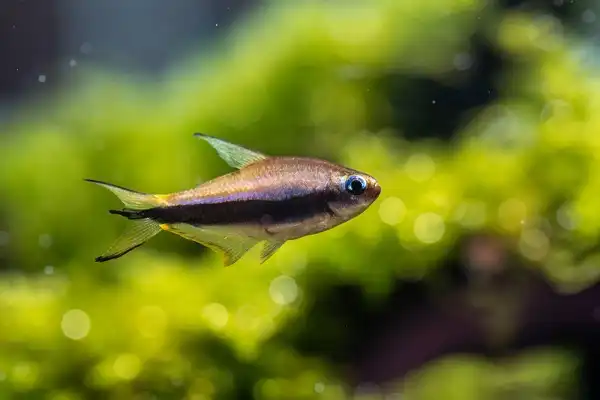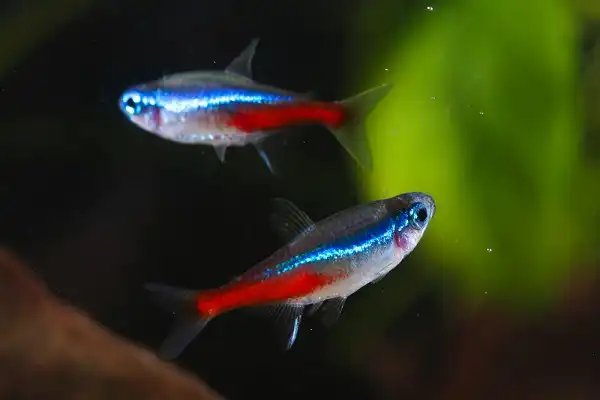Are you looking to add a dazzling new addition to your aquarium? Tetra fish are the perfect blend of exotic color and peaceful demeanor that can bring life and vibrancy to any tank. These small, freshwater fish come in a variety of vividly colored varieties, each with their own distinct personalities that make for ideal companions for all aquarists! Whether you’re just starting out or an experienced veteran, adding tetras is sure to be a rewarding experience — one you’ll never forget! In this blog post, we will explore all the delightful things about these pocket-sized powerhouses from what makes them so special to how they should be cared for. So if you’ve been considering getting some tetras of your own or would like advice on taking better care of the ones you already have – keep reading!

Tetra Description
Tetra fish are known for their strikingly vibrant and varied colors, ranging from bright reds, oranges, and yellows to deep blues, greens, and even black. The most common types of tetras include neon tetras, black skirt tetras, serape tetras, and von Rio tetras, each with unique personalities and behaviors. While tetras are small in size, they are full of energy and curiosity, constantly exploring their environment and interacting with other fish. They thrive in groups and prefer a heavily planted aquarium with plenty of hiding spots and swimming space. It is important to maintain proper water parameters for the health and well-being of tetras, as they are sensitive to changes in water quality. Regular water changes and a well-functioning filtration system are essential in keeping tetras healthy and happy.
Tetra Habitat
Tetra fish are native to South America, specifically the Amazon River basin, and can also be found in other parts of the continent such as Peru and Bolivia. Their natural habitat includes slow-moving streams, tributaries, and flooded forest areas with plenty of vegetation. In the wild, tetras are known to live in large schools and use their bright colors as a form of communication and identification among their own species. When creating an aquarium habitat for tetras, it is important to replicate their natural environment as much as possible. This includes providing a densely planted tank with a variety of live plants and driftwood. The plants not only offer hiding spots but also help to filter the water and maintain the balance of the aquarium ecosystem. The addition of leaf litter and botanicals such as alder cones and catappa leaves can also help to simulate the natural conditions of their habitat. In terms of water chemistry, tetras prefer soft and slightly acidic water with a pH range of 6.4 to 7.0. The ideal water temperature for tetras is between 72 to 82 degrees Fahrenheit. It is essential to monitor the water parameters regularly and perform regular water changes to ensure that the water quality is within the range of what is ideal for tetras.
Tetra Diet
Tetras are a type of omnivorous fish that require a balanced diet to thrive. Their diet consists of both animal and plant-based foods. A high-quality fish flake or pellet should be the staple of their diet, as it provides important nutrients such as protein, vitamins, and minerals. In addition to fish flakes and pellets, tetras can also be fed a variety of frozen or live foods such as bloodworms, brine shrimp, and daphnia. These foods provide an excellent source of protein and can be used as a treat or supplement to their regular diet. It is important to feed tetras small amounts of food throughout the day, rather than one large feeding. Overfeeding can lead to digestive problems, as well as cause a decrease in water quality. Some owners choose to supplement their tetras’ diet with fresh or frozen fruits and vegetables such as peas, spinach, and cucumber. However, care should be taken to avoid feeding them too much plant material, as tetras are predominantly carnivorous and require a diet rich in protein.

Tetra Size
Tetras are small, active fish that are popular among aquarium hobbyists. There are several different species of tetra, each with its own specific size range. On average, tetras grow to be around 1 to 2 inches in length. It is important to note that while tetras are small in size, they still require ample swimming space to thrive. A general rule of thumb is to provide at least one gallon of water per inch of fish, meaning a tank with 10 gallons of water can comfortably house up to 10 tetras. In terms of specific tetra species, some are smaller than others. For example, the neon tetra is one of the smallest, growing up to only 1 inch in length. On the other hand, the emperor tetra can grow up to 3 inches in length. When selecting a tank for your tetras, it is important to consider not just the size of the fish, but also their behavior. Tetras are active swimmers that enjoy exploring their environment, so providing ample swimming space is crucial.
Tetra Lifespan
Tetras, the small, colorful fish popular among aquarium hobbyists, have a lifespan of approximately 3 to 5 years, depending on the species and environmental conditions they are kept in. Factors that can impact a tetra’s lifespan include water quality, temperature, diet, and overall care. It is essential to ensure that the aquarium is kept clean and well-maintained to avoid any potential health issues caused by poor water quality. Additionally, maintaining a consistent temperature and following a proper feeding regimen are crucial to their well-being. In the wild, tetras typically live in groups and experience seasonal variations in their environment. Mimicking their natural habitat in the aquarium can help promote a healthy and long lifespan. Including appropriate tank mates, such as other peaceful community fish, can also help reduce stress levels and promote a healthy environment.
Tetra Behavior
Tetras are small, active fish that are known for their lively and social behavior. They are peaceful and prefer to live in groups of at least 6 to 8 individuals. Some species, like the neon tetra, will school together tightly, while others, such as the black skirt tetra, will school more loosely. Tetras have an active and curious personality that makes them great additions to any community aquarium. They are constantly exploring their environment and are known for their playful darting movements. Tetras also have the unique ability to change their colors based on their mood and environment. For example, when stressed or scared, tetras may become paler or more subdued in color. In terms of territorial behavior, tetras generally do not exhibit aggressive behavior towards other fish. However, males may engage in minor squabbles over territory, especially during the breeding season. It is important to provide ample hiding places and visual barriers in the aquarium to minimize any potential territorial disputes.

Tetra Speed
Tetras are small, active fish that move quickly through their aquarium environment. They have a reputation for being strong swimmers and can swim up to 2-3 mph, depending on the species. The speed of tetras varies between species and is also influenced by water temperature and oxygen levels in the aquarium. In general, faster-moving species such as the neon tetra can reach speeds up to 3 mph, while slower-moving species like the black skirt tetra typically max out at around 1-2 mph. In addition to their swift swimming abilities, tetras are known for their lively behavior and playful darting movements. This makes them great additions to any community aquarium with other peaceful fish.
Tetra Hunting
In the wild, tetras are skilled hunters and will often venture out in search of food. In the aquarium, they will also actively seek out food items but may need additional encouragement to hunt if there is not enough natural vegetation or live food available. Providing a variety of foods such as small pellets, flakes, freeze-dried, and live foods such as brine shrimp, bloodworms, and daphnia can help stimulate their hunting instincts. Live plants can also be added to the aquarium to give them something more interesting to explore. Tetras are active fish that require plenty of open swimming space to stay healthy and happy.

Conclusion
Tetras are active, social fish that make wonderful additions to any community aquarium. They require a well-maintained environment with plenty of open swimming space and appropriate tank mates to stay healthy and active. With the correct care and diet, tetras can live for up to five years in captivity, providing continuous enjoyment to their owners. Overall, these small but mighty fish can bring life and energy to any aquarium!
Frequently Asked Question


